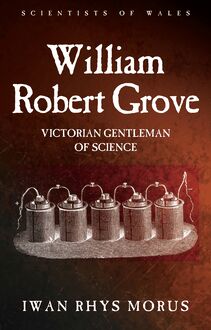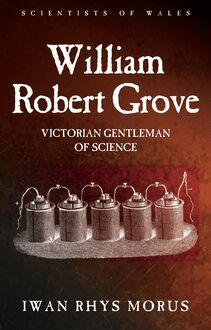-
 Univers
Univers
-
 Ebooks
Ebooks
-
 Livres audio
Livres audio
-
 Presse
Presse
-
 Podcasts
Podcasts
-
 BD
BD
-
 Documents
Documents
-
- Cours
- Révisions
- Ressources pédagogiques
- Sciences de l’éducation
- Manuels scolaires
- Langues
- Travaux de classe
- Annales de BEP
- Etudes supérieures
- Maternelle et primaire
- Fiches de lecture
- Orientation scolaire
- Méthodologie
- Corrigés de devoir
- Annales d’examens et concours
- Annales du bac
- Annales du brevet
- Rapports de stage
La lecture à portée de main
Vous pourrez modifier la taille du texte de cet ouvrage
Découvre YouScribe en t'inscrivant gratuitement
Je m'inscrisDécouvre YouScribe en t'inscrivant gratuitement
Je m'inscrisEn savoir plus
Vous pourrez modifier la taille du texte de cet ouvrage
En savoir plus

Description
This book provides an accessible and authoritative biography of the Welsh man of science, William Robert Grove. Grove was an important and highly influential figure in Victorian science. His career as both man of science and leading barrister and judge spanned the Victorian age, and he also played a vital role in the movement to reform the Royal Society. This biography will set Grove’s career and contributions in context, paying particular attention to the important role of Welsh industrial culture in forming his scientific outlook. The place of science in culture changed radically during the course of the nineteenth century, and Grove himself played a key role in some of those transformations. Looking at his life in science can, however, do more than illuminate an individual scientific career – it can offer a way of gaining new insights into the changing face of Victorian science.
Sujets
Informations
| Publié par | University of Wales Press |
| Date de parution | 05 janvier 2017 |
| Nombre de lectures | 0 |
| EAN13 | 9781786830067 |
| Langue | English |
| Poids de l'ouvrage | 3 Mo |
Informations légales : prix de location à la page 0,0524€. Cette information est donnée uniquement à titre indicatif conformément à la législation en vigueur.
Extrait
SCIENTISTS OF WALES
William Robert Grove
SCIENTISTS OF WALES
Series Editor
Professor Gareth Ffowc Roberts
Bangor University
Editorial Panel
John V. Tucker
Swansea University
Iwan Rhys Morus
Aberystwyth University
SCIENTISTS OF WALES
William Robert Grove
VICTORIAN GENTLEMAN OF SCIENCE
IWAN RHYS MORUS -->
UNIVERSITY OF WALES PRESS 2017
© Iwan Rhys Morus, 2017
All rights reserved. No part of this book may be reproduced in any material form (including photocopying or storing it in any medium by electronic means and whether or not transiently or incidentally to some other use of this publication) without the written permission of the copyright owner except in accordance with the provisions of the Copyright, Designs and Patents Act 1988. Applications for the copyright owner s written permission to reproduce any part of this publication should be addressed to the University of Wales Press, 10 Columbus Walk, Brigantine Place, Cardiff CF10 4UP.
www.uwp.co.uk
British Library Cataloguing-in-Publication Data
A catalogue record for this book is available from the British Library.
ISBN 978-1-78683-020-3 hardback
978-1-78683-004-3 paperback
eISBN 978-1-78683-006-7
The right of Iwan Rhys Morus to be identified as author of this work has been asserted in accordance with sections 77, 78 and 79 of the Copyright, Designs and Patents Act 1988.
Cover image: The Grove cell battery, first developed 1838-9 (image source Alamy).
i fy nhad
CONTENTS
Series Editor s Foreword
List of Illustrations
Prologue
1 A Scientific People
2 The Metropolis of Science
3 The Correlation of Physical Forces
4 Scientific Reform
5 Swansea Science
6 Unifying Science
7 A Scientific Statesman
Afterword
Notes
Bibliography
SERIES EDITOR S FOREWORD
W ales has a long and important history of contributions to scientific and technological discovery and innovation stretching from the Middle Ages to the present day. From medieval scholars to contemporary scientists and engineers, Welsh individuals have been at the forefront of efforts to understand and control the world around us. For much of Welsh history, science has played a key role in Welsh culture: bards drew on scientific ideas in their poetry; renaissance gentlemen devoted themselves to natural history; the leaders of early Welsh Methodism filled their hymns with scientific references. During the nineteenth century, scientific societies flourished and Wales was transformed by engineering and technology. In the twentieth century the work of Welsh scientists continued to influence developments in their fields.
Much of this exciting and vibrant Welsh scientific history has now disappeared from historical memory. The aim of the Scientists of Wales series is to resurrect the role of science and technology in Welsh history. Its volumes trace the careers and achievements of Welsh investigators, setting their work within their cultural contexts. They demonstrate how scientists and engineers have contributed to the making of modern Wales as well as showing the ways in which Wales has played a crucial role in the emergence of modern science and engineering.
RHAGAIR GOLYGYDD Y GYFRES
O r Oesoedd Canol hyd heddiw, mae gan Gymru hanes hir a phwysig o gyfrannu at ddarganfyddiadau a menter gwyddonol a thechnolegol. O r ysgolheigion cynharaf i wyddonwyr a pheirianwyr cyfoes, mae Cymry wedi bod yn flaenllaw yn yr ymdrech i ddeall a rheoli r byd o n cwmpas. Mae gwyddoniaeth wedi chwarae rôl allweddol o fewn diwylliant Cymreig am ran helaeth o hanes Cymru: arferai r beirdd llys dynnu ar syniadau gwyddonol yn eu barddoniaeth; roedd gan w ŷ r y Dadeni ddiddordeb brwd yn y gwyddorau naturiol; ac roedd emynau arweinwyr cynnar Methodistiaeth Gymreig yn llawn cyfeiriadau gwyddonol. Blodeuodd cymdeithasau gwyddonol yn ystod y bedwaredd ganrif ar bymtheg, a thrawsffurfiwyd Cymru gan beirianneg a thechnoleg. Ac, yn ogystal, bu gwyddonwyr Cymreig yn ddylanwadol mewn sawl maes gwyddonol a thechnolegol yn yr ugeinfed ganrif.
Mae llawer o r hanes gwyddonol Cymreig cyffrous yma wedi hen ddiflannu. Amcan cyfres Gwyddonwyr Cymru yw i danlinellu cyfraniad gwyddoniaeth a thechnoleg yn hanes Cymru, â i chyfrolau n olrhain gyrfaoedd a champau gwyddonwyr Cymreig gan osod eu gwaith yn ei gyd-destun diwylliannol. Trwy ddangos sut y cyfrannodd gwyddonwyr a pheirianwyr at greu r Gymru fodern, dadlennir hefyd sut y mae Cymru wedi chwarae rhan hanfodol yn natblygiad gwyddoniaeth a pheirianneg fodern.
LIST OF ILLUSTRATIONS
Figure 1 William Robert Grove, Portraits of Men of Eminence in Literature, Science, and Art, with Biographical Memoirs, the Photographs from Life, by Ernest Edwards, BA (London: Alfred William Bennett, 1865).
Figure 2 The Gas Battery, Philosophical Transactions , 1843.
Figure 3 Somerset House, Meeting of the Royal Society, engraved by H. Melville after a picture by Fairholt, published in London Interiors , 1845.
Figure 4 Map of locations for the Swansea meeting of the British Association for the Advancement of Science, 1848.
Figure 5 A Soirée at the Swansea meeting of the British Association for the Advancement of Science, drawing by John Weir Padley. National Library of Wales.
Figure 6 Discharge experiments, Philosophical Transactions , 1858.
Figure 7 Cartoon of Mr Justice Grove, from Vanity Fair , 1887.
Figure 8 Frontispiece of Henry M. Noad, Lectures on Electricity , 1844.
PROLOGUE
I t is quite easy to imagine an alternative steampunk universe in which William Robert Grove is celebrated as the inaugurator of a second Victorian industrial revolution. In this parallel world, his invention of the gas battery in 1841 revolutionised transportation, and killed off the steam locomotive before it had a chance to monopolise the railways. Banks of gas batteries, fuelled by cheap hydrogen produced from coal, powered horseless carriages on the roads as well as the railways, making possible fast and reliable travel beyond the confines of the rail network. The cheap power generated from coal-produced hydrogen quickly made electricity a serious competitor for steam in a variety of industries too. Crucially, the gas battery brought electricity into the Victorian home as well. By the 1860s, large gasometers filled with hydrogen were a common sight in Victorian towns and cities. Networks of pipes carried the gas to middle-class homes to provide fuel for gas batteries that powered not only electric lights but the whole range of electrical gadgetry that packed Victorian houses. Appliances for washing dishes, doing the laundry, cleaning carpets and curtains, even cooking, were all powered using Grove s ubiquitous gas batteries. They operated the magic lanterns that provided middle-class Victorians with their evening s domestic entertainment.
None of this happened, of course. But let us imagine another alternative history instead, observed this time from the perspective of the twenty-second century. In this history, Grove is the hero again. During the early decades of the twenty-first century - nearly two centuries after it was invented - Grove s gas battery, now called the fuel cell, transformed transportation. It provided a solution to increasingly urgent problems of climate change and the pollution produced by hydrocarbon-based fossil fuels. Cars and lorries powered by fuel cells, running on hydrogen gas generated by electrolysis using solar power, inaugurated a revolution in low-emission travel. The only by-product of combining hydrogen and oxygen to make electricity is water, after all. The fuel cell generated none of the greenhouse gases that bedevilled the traditional petrol- or diesel-powered internal combustion engine. It helped too that it ran on fuel that could be found anywhere there was water, rather than one derived from increasingly scarce and expensive to acquire oil. Grove s gas battery therefore played a key role in the battle to reduce environmentally harmful emissions and contain climate change that dominated the second half of the twenty-first century and Grove himself became an icon for the drive towards clean energy.
This has not happened yet, of course. But there are signs already that this really is one plausible route that the history of twenty-first-century energy use might follow. In the years immediately following his invention, Grove s gas battery received very little attention other than as a philosophical curiosity. It certainly did not strike anyone at the time - Grove included - as a potential source of power on an industrial scale, even though many electricians at the time already regarded electric power as a viable competitor for steam. Grove did suggest in 1854,
that if, instead of using zinc and acids, which are manufactured, and comparatively expensive materials, for the production of electricity, we could realize the electricity developed by the combustion in atmospheric air, of common coal, wood, fat, or other raw material, we should have at once a fair prospect of the commercial application of electricity. 1
He did nothing about it though. Others such as Lord Rayleigh and Ludwig Mond did make attempts to turn the gas battery into a practical, commercially viable technology but again they went nowhere. 2 Now, on the other hand, car manufacturers such as Toyota are pouring significant resources into developing fuel cell-powered electric vehicles. Grove s gas battery seems set to become the technology of the future.
I am putting these two sketches of alternative and future histories forward here, however, because thinking about them might help us understand the current place in history of this biography s subject, the Welsh Victorian man of science William Robert Grove. Grove is in many ways a curious historical figure. For much of his own lifetime he was widely considered by his contemporaries to be one of the Victorian Age s leading men of science. By the end of his life, however, he was an increasingly margin
-
 Univers
Univers
-
 Ebooks
Ebooks
-
 Livres audio
Livres audio
-
 Presse
Presse
-
 Podcasts
Podcasts
-
 BD
BD
-
 Documents
Documents
-
Jeunesse
-
Littérature
-
Ressources professionnelles
-
Santé et bien-être
-
Savoirs
-
Education
-
Loisirs et hobbies
-
Art, musique et cinéma
-
Actualité et débat de société
-
Jeunesse
-
Littérature
-
Ressources professionnelles
-
Santé et bien-être
-
Savoirs
-
Education
-
Loisirs et hobbies
-
Art, musique et cinéma
-
Actualité et débat de société
-
Actualités
-
Lifestyle
-
Presse jeunesse
-
Presse professionnelle
-
Pratique
-
Presse sportive
-
Presse internationale
-
Culture & Médias
-
Action et Aventures
-
Science-fiction et Fantasy
-
Société
-
Jeunesse
-
Littérature
-
Ressources professionnelles
-
Santé et bien-être
-
Savoirs
-
Education
-
Loisirs et hobbies
-
Art, musique et cinéma
-
Actualité et débat de société
- Cours
- Révisions
- Ressources pédagogiques
- Sciences de l’éducation
- Manuels scolaires
- Langues
- Travaux de classe
- Annales de BEP
- Etudes supérieures
- Maternelle et primaire
- Fiches de lecture
- Orientation scolaire
- Méthodologie
- Corrigés de devoir
- Annales d’examens et concours
- Annales du bac
- Annales du brevet
- Rapports de stage




















